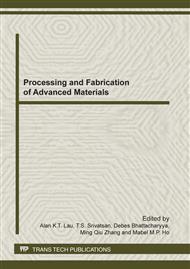p.313
p.317
p.321
p.325
p.329
p.333
p.337
p.341
p.345
Study of B. Mori Silk Fabric and B. Mori Silk Reinforced Epoxy Composite
Abstract:
In this work, degummed (Bombyx mori)silk fabric was used as a bio-reinforcement for epoxy composite.The silk fabric was in a form of plain weaving with 177 ends/10 cm x 201 picks/10 cm. The degummed silk fabric (dSF)/epoxy composites were prepared by hand lay-up with dSF weight fraction of 0.18-0.35. The dSF was characterized using a universal testing machine (UTM) and a thermogravimetric analyzer (TGA). Mechanical properties including tensile properties, and impact property of neat epoxy and epoxy composites were investigated using a UTM and a impact testing machine, respectively. Thermal properties of neat epoxy and dSF/epoxy composites were investigated using a TGA. In addition, morphology of fracture surface of neat epoxy and dSF/epoxy composite were examined via a scanning electron microscope. Tensile strength of dSF was not significantly dependent in direction, was 537.1 N in warp direction, and 555 N in weft direction. In addition, dSF decomposed at 324°C under nitrogen atmosphere. The tensile strength and impact strength of the neat epoxy were higher than those of dSF/epoxy composites. However, tensile strength and impact strength tended to increased with increasing dSF content. On the other hand, Young’s modulus was improved by addition of dSF. The dSF/epoxy composites still fractured in a brittle manner.
Info:
Periodical:
Pages:
329-332
Citation:
Online since:
November 2011
Authors:
Price:
Сopyright:
© 2012 Trans Tech Publications Ltd. All Rights Reserved
Share:
Citation:


